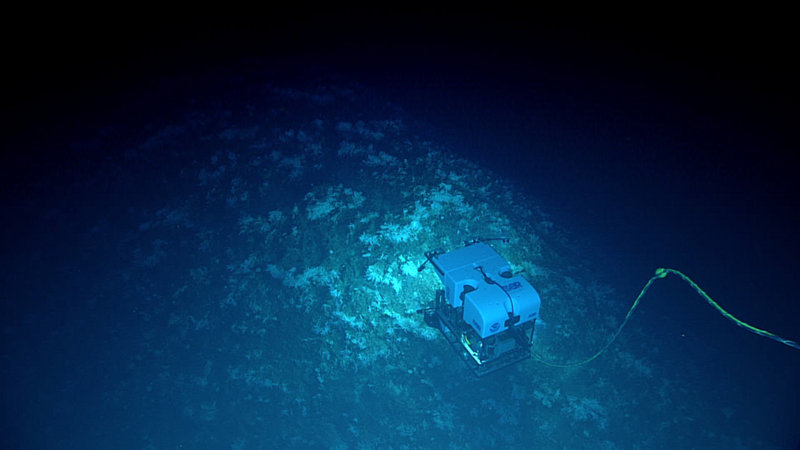How do hurricanes impact the deep ocean?
Disturbances such as waves caused by strong hurricane winds do not reach the deep ocean; however, churning of surface waters can result in more food falling to the seafloor

Remotely operated vehicle Deep Discoverer explores a coral mound off the Gulf coast of Florida at a depth of approximately 800 meters (2,625 feet) -- well below the depth that severe storms have been measured to cause disturbances. Image courtesy of the NOAA Office of Ocean Exploration and Research, 2019 Southeastern U.S. Deep-sea Exploration. Download larger version (jpg, 182 KB).
While the physical effects of hurricanes on near-shore ecosystems, such as shallow-water coral reefs and estuaries, are well documented, little research has been conducted on the direct impacts of hurricanes on the deep sea. Due to their remote nature, observations of deep-ocean ecosystems are scarce, and even more so during or after extreme weather events like a hurricane.
The churning of waves and strong winds which can have strong influences on shallow-water ecosystems are felt much less profoundly by the deep-sea animals encountered during remotely operated vehicle (ROV) dive. In fact, measurable disturbances of a hurricane only reach a maximum depth of about 90 meters (~300 feet) below the surface—the approximate height of the Statue of Liberty. For reference, the shallowest depth that the NOAA Office of Ocean Exploration and Research’s ROV Deep Discoverer explores is 250 meters (~820 feet), with a maximum diving depth of 6,000 meters (~19,685 feet).
However, there may be an unexpected benefit for deep-sea life after the storm passes. As a hurricane moves across the ocean, the force of the storm churns up water, mixing warmer water at the surface with cooler, nutrient rich water from farther down in the water column, in a process known as upwelling. Upwelling is a powerful force that can help drive food production in the ocean. The deep waters it brings to the surface provide nutrients to phytoplankton, the primary producers that make most of the food in the ocean. With plenty of nutrients to fuel photosynthesis, phytoplankton will bloom, in turn providing food for other organisms. Generally, only a small fraction of the organic matter produced by phytoplankton and the organisms that feed on them at the surface makes its way to the seafloor as a food source for the animals that live there. This is because much of this food is recycled and retained within the photic zone, the shallow waters where phytoplankton live. However, just like when you cook too much food for an event, a big plankton bloom can lead to a lot of leftovers, and this excess of organic matter will then sink to the waters below, providing food for deep-sea animals.